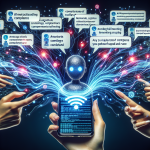Understanding Hyperpersonalization in E-commerce
Traditional e-commerce experiences are being rapidly transformed by emerging technologies. One of the most significant evolutions is the rise of hyperpersonalization—an AI-powered approach that delivers uniquely curated digital experiences for each customer. Unlike basic personalization, which may include simply suggesting related products or addressing users by name, hyperpersonalized e-commerce leverages advanced data analytics, machine learning, and real-time user behavior to craft entirely bespoke shopping environments.
The Role of AI in Delivering Hyperpersonalized Shopping Experiences
Artificial Intelligence (AI) is the engine driving hyperpersonalization in online retail. Through a combination of natural language processing (NLP), predictive analytics, and recommendation algorithms, AI can analyze vast datasets—from browsing history and purchase patterns to social media activity and geolocation. This intelligence allows e-commerce platforms to present:
- Custom product recommendations based on individual preferences
- Dynamically changing landing pages
- Tailored content like blog posts, videos, and how-to guides
- Adaptable pricing strategies and discounts
- Personalized email and SMS marketing campaigns
Rather than a one-size-fits-all web interface, users encounter a digital storefront that seems to intuitively understand their needs and desires.
Key Technologies Enabling Hyperpersonalized Pages
Several cutting-edge technologies are contributing to the creation of hyperpersonalized e-commerce experiences:
1. Behavioral Analytics
Behavioral analytics tools observe how users interact with a website—click paths, time spent on pages, product views—and translate this information into actionable insights to adapt web interfaces in real time.
2. Machine Learning Algorithms
Machine learning (ML) helps platforms predict what a shopper might want next by training on historical data. These algorithms refine their outputs as they gather more user interactions, improving recommendation precision continuously.
3. Customer Data Platforms (CDPs)
CDPs consolidate customer data from multiple sources (social media, CRM systems, web history) into a unified profile. This 360-degree view enables AI systems to generate more sophisticated hyperpersonalized outputs.
4. Natural Language Processing (NLP)
NLP powers chatbots and search optimization by understanding user intent and language. It helps create dynamic content and interactive experiences that respond naturally to user input.
5. Real-Time Personalization Engines
These engines use live data—such as time of day, weather, device type—to instantly adjust UI components, banners, and recommendations, tailoring the e-commerce experience in the moment.
Benefits for Retailers and Shoppers
Hyperpersonalized e-commerce pages offer several advantages:
For Retailers:
- Increased conversion rates through more relevant recommendations
- Boost in average order value (AOV)
- Improved customer retention and loyalty
- Better ROI on marketing campaigns
For Shoppers:
- Simplified navigation with curated selections
- More efficient purchasing process
- Enhanced enjoyment through relevant experiences
- Greater satisfaction and trust in the brand
Challenges and Considerations
Despite its promise, hyperpersonalization comes with potential hurdles. Privacy concerns arise when collecting and analyzing user data. Retailers must comply with data protection regulations like GDPR and CCPA, ensuring transparency and giving users control over their data.
Additionally, overpersonalization can feel invasive, making it essential for e-commerce platforms to strike the right balance between helpful recommendations and respecting personal boundaries.
The Future of Hyperpersonalized E-commerce
As AI and data-driven technologies advance, hyperpersonalized e-commerce will only become more refined. Emerging trends include:
- AI-generated product imagery: Creating visuals tailored to user preferences.
- Voice commerce integration: Personalized interactions via virtual assistants.
- Augmented reality (AR) integrations: Delivering customized try-before-you-buy experiences.
- Ultra-localized content: Products and promotions based on precise regional trends and behaviors.
In the next few years, seamless and intelligent digital storefronts will become the norm, setting a new expectation for what online shopping should feel like.
Conclusion
Hyperpersonalized e-commerce pages, powered by AI, are revolutionizing how consumers interact with online stores. With technologies like machine learning, behavioral analytics, and real-time personalization engines, brands can craft deeply individualized experiences that not only boost revenue but also improve customer satisfaction. As innovation continues, the boundary between digital commerce and personalized customer service will blur, leading to smarter and more human-centric shopping journeys.







